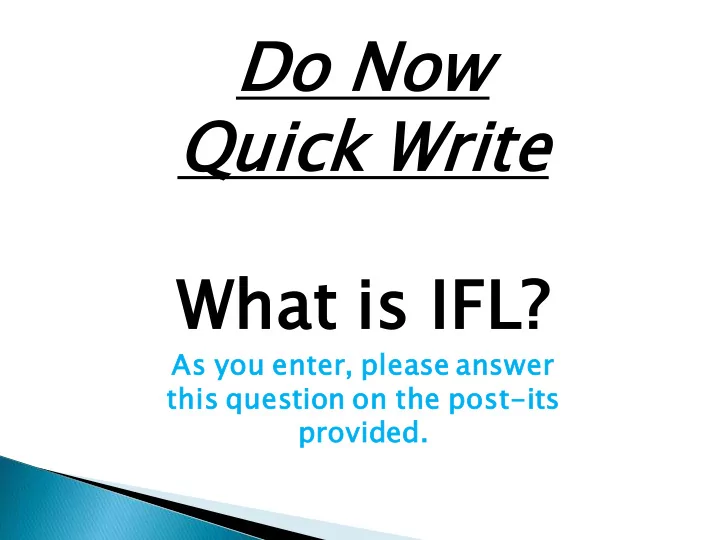

Do Now Quick Write What t is IFL? As you enter, please se answer this s quest stion n on the post-its s provided.
What is IFL? The Institut ute for Learni ning ng A non-profit Learning Research and Development Center out of the University of Pittsburgh that serves large percentages of impoverished and language-diverse students.
Nine Princi ciples s of Learni ning ng 1.Organizing for Effort 2.Clear Expectations 3.Fair and Credible Evaluations 4.Recognition of Accomplishment 5.Academic Rigor in a Thinking Curriculum 6.Socializing Intelligence 7.Self-Management of Learning 8.Learning as Apprenticeship 9. 9. Accountable Talk…
DOL Given the information presented today, accurately explain what an Accountable Talk classroom looks like in 2-3 sentences.
Now which picture do you think shows a class using Accountable Talk?
Accountable Talk is one of the Institute For Learning’s (IFL) nine Principles of Learning. Talking with others about ideas and work is fundamental to learning. Not all talk sustains learning. In order for classroom talk to promote learning, it must be accountable – to the learning community, to accurate and appropriate knowledge, and to rigorous thinking.
Accountable Talk… students respond to and further develop what others in the group have said accurate and relevant knowledge to the topic under discussion requires active/attentive listening requires the use of evide idence
How does Accountable Talk fit in? ◦ addresses the Speaking and Listening standards ◦ not to be used as a posted objective or DOL ◦ infused within daily instruction ◦ part of your walkthroughs and summative teacher evaluation
In classrooms where high levels of student engagement and Accountable Talk are prevalent: ◦ Students are able to explain the relationship between the discussion and the stated learning objectives ◦ The teacher and students ask questions that require higher order thinking (synthesis, analysis, evaluation, problem solving, application of learning) ◦ Students return to the text and other data sources to support their positions or challenge the positions taken by others in the discussion ◦ All students take an active role in the discussion using agreed upon norms ◦ Anchor charts that outline norms for discussion and specific group discussion strategies are displayed
The teacher utilizes various discussion strategies and routines (pairs, small group, full class, turn and talk, think-pair-share, fishbowl, inside/outside circles, jigsaw) appropriate to the lesson’s learning objective and the learning needs of the students. As you watch the e video deo, take e note e of the e roles es of f the e teac acher er and d studen ents duri ring the e discussion. ◦ http://www.engageny.org/resource/a-protocol- for-citing-evidence-from-informational-text- from-expeditionary-learning
The teacher models these strategies and routines with students. Over time, s/he gradually releases the responsibility of leading the discussion to the students. During the release of responsibility, the teacher periodically acts as a participant or facilitator, especially when marking key points made by those in the group. The teacher challenges the group by redirecting a question back to a person, when recapping what was said in a discussion, and when pressing for accuracy.
Revoicing: “So let me see if I’ve got your thinking right. You’re saying XXX?” Asking students to restate someone else’s reasoning: “Can you repeat what ___ said in your own words?” Asking students to apply their own reasoning to that of a peer: “Do you agree or disagree with ___ and why?” Prompting for further participation: “Would someone like to add on to what has been said?” Asking students to explain their reasoning: “Why do you think that?” or “How did you arrive at that answer?” or “Can you say more about that?” Challenge students: “Is this always true?” or “Can you think of any examples that would not work?”
I wonder why… I have a question about… I agree/disagree with…because… That reminds me of… I don’t understand… I predict… On page ____ it says______ so I think… ____ could you please clarify what you mean when you said_____ I would like to add to what ___ was saying I had a different opinion to what ___ was saying because I thought _____ I came to the conclusion ____ because
What to watch for… ◦ What evidence of Accountable Talk do you see in this video? ◦ How might the classroom conversation seen here help students become better readers? ◦ http://vimeo.com/55950928
Let’s have our own Accountable Talk discussion! Read the following article, The School-to-Prison Pipeline. • Think about the following while reading: • Do you agree or disagr gree with th the author of this article? Be prepared to support t your reasoning g with th evidence from the text. t.
Given the information presented today, accurately explain what an Accountable Talk classroom looks like in 2-3 sentences.
Anchor Charts or talking stem posters to hang in your room
Additional videos and resources to help get started using Accountable Talk in classrooms can be found on the Institute for Learning Website ◦ To access the website Go to www.instituteforlearning.org Click on the LOGIN link at the upper-left corner of the screen above the IFL logo Click on the MEMBER DISTRICT SITES in the left sidebar Scroll down the list of districts and click on There are multiple sections that can be accessed, each with its own username and password Leadership section: Username: ifl-paterson Password: ifl-paterson-2011 Disciplinary Literacy section: Username: dl-paterson Password: dl-paterson-2011
Principles of Learning: Study Tools for Educators. University of Pittsburgh. www.teacherparentresources.com www.engageny.com Start small, think BIG!!!! Start now, don’t wait until January !
Recommend
More recommend